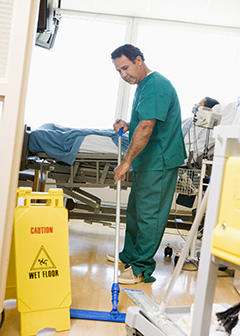Nursing Assistant or Orderly
Nursing Assistant or Orderly
Does this career fit your work personality?
Begin The Career Assessment Test- Best Fitting Careers
- Work Personality Strengths
- Work Style Preferences
- and more
What Nursing Assistants and Orderlies Do
Nursing assistants, sometimes called nursing aides, provide basic care and help patients with activities of daily living. Orderlies transport patients and clean treatment areas.
Duties
Nursing assistants and orderlies work as part of a healthcare team under the supervision of licensed practical or licensed vocational nurses and registered nurses.
Nursing assistants provide basic care and help with activities of daily living. They typically do the following:
- Clean and bathe patients
- Help patients use the toilet and dress
- Turn, reposition, and transfer patients between beds and wheelchairs
- Listen to and record patients’ health concerns and report that information to nurses
- Measure patients’ vital signs, such as blood pressure and temperature
- Serve meals and help patients eat
Depending on their training level and the state in which they work, nursing assistants also may dispense medication.
Nursing assistants are often the principal caregivers in nursing and residential care facilities. Nursing assistants often develop relationships with their patients because some patients stay in these facilities for months or years.
Orderlies typically do the following:
- Help patients to move around the facility, such as by pushing their wheelchairs
- Clean equipment and facilities
- Change linens
- Stock supplies
Work Environment

Nursing assistants held about 1.4 million jobs in 2022. The largest employers of nursing assistants were as follows:
| Nursing care facilities (skilled nursing facilities) | 33% |
| Hospitals; state, local, and private | 33 |
| Continuing care retirement communities and assisted living facilities for the elderly | 11 |
| Home healthcare services | 6 |
| Government | 4 |
Orderlies held about 45,500 jobs in 2022. The largest employers of orderlies were as follows:
| Hospitals; state, local, and private | 85% |
| Ambulatory healthcare services | 6 |
| Government | 1 |
The work of nursing assistants and orderlies may be strenuous. They spend much of their time on their feet as they care for patients.
Injuries and Illnesses
Nursing assistants and orderlies have one of the highest rates of injuries and illnesses of all occupations. These workers frequently move patients and have other physically demanding tasks. They typically get training in how to properly lift people, which can reduce the risk of injuries.
Work Schedules
Although most nursing assistants and orderlies work full time, some work part time. Because nursing and residential care facilities and hospitals provide care at all hours, nursing assistants and orderlies may need to work nights, weekends, and holidays.
Getting Started
How to Become a Nursing Assistant or Orderly

Nursing assistants typically must complete a state-approved education program and pass their state’s competency exam. Orderlies typically have at least a high school diploma or equivalent.
Education and Training
Nursing assistants often need to complete a state-approved education program that includes both instruction on the principles of nursing and supervised clinical work. These programs are available in high schools, community colleges, vocational and technical schools, hospitals, and nursing homes.
In addition, nursing assistants typically complete a brief period of on-the-job training to learn about their specific employer’s policies and procedures.
Orderlies typically have at least a high school diploma or equivalent and receive a short period of on-the-job training.
Licenses, Certifications, and Registrations
Specific requirements for nursing assistants vary by state. Nursing assistants often need a state-issued license or certification. After completing an approved education program, nursing assistants often must pass a competency exam, which allows them to use state-specific titles. In some states, a nursing assistant is called a Certified Nursing Assistant (CNA), but titles vary by state.
Nursing assistants who have passed the competency exam are placed on a state registry. They must be on the state registry to work in a nursing home.
Some states have other requirements as well, such as continuing education and a criminal background check. Check with state certifying agencies for more information.
In some states, nursing assistants may earn additional credentials, such as Certified Medication Assistant (CMA). As a CMA, they may dispense medications.
Orderlies do not need a license; however, jobs might require certification in cardiopulmonary resuscitation (CPR) or basic life support (BLS).
Job Outlook
Overall employment of nursing assistants and orderlies is projected to grow 4 percent from 2022 to 2032, about as fast as the average for all occupations.
About 209,400 openings for nursing assistants and orderlies are projected each year, on average, over the decade. Many of those openings are expected to result from the need to replace workers who transfer to different occupations or exit the labor force, such as to retire.
Employment
As the baby-boom population ages, nursing assistants and orderlies will be needed to help care for an increasing number of older people who have chronic or progressive diseases, such as heart disease and diabetes.
Demand for nursing assistants may be constrained by financial pressures on nursing homes, which might lead some facilities to close or reduce staff. However, increased opportunities are expected in home- and community-based settings as patient preferences and shifts in federal and state funding generate demand for care in these settings.
Contacts for More Information
For information about healthcare assistants, visit
National Association of Health Care Assistants (NAHCA)
For more information about state requirements, visit
National Council of State Boards of Nursing
Occupational Requirements Survey
For a profile highlighting selected BLS data on occupational requirements, see
Nursing assistants (PDF)
Similar Occupations
This table shows a list of occupations with job duties that are similar to those of nursing assistants and orderlies.
| Occupation | Job Duties | Entry-Level Education | Median Annual Pay, May 2022 | |
|---|---|---|---|---|

|
Home Health and Personal Care Aides |
Home health and personal care aides monitor the condition of people with disabilities or chronic illnesses and help them with daily living activities. |
High school diploma or equivalent | $30,180 |

|
Licensed Practical and Licensed Vocational Nurses |
Licensed practical nurses (LPNs) and licensed vocational nurses (LVNs) provide basic medical care. |
Postsecondary nondegree award | $54,620 |

|
Medical Assistants |
Medical assistants complete administrative and clinical tasks, such as scheduling appointments and taking patients’ vital signs. |
Postsecondary nondegree award | $38,270 |

|
Occupational Therapy Assistants and Aides |
Occupational therapy assistants and aides help patients develop, recover, improve, as well as maintain the skills needed for daily living and working. |
See How to Become One | $63,450 |

|
Psychiatric Technicians and Aides |
Psychiatric technicians and aides care for people who have mental conditions or developmental disabilities. |
See How to Become One | $37,330 |

|
Physical Therapist Assistants and Aides |
Physical therapist assistants and aides are supervised by physical therapists to help patients regain movement and manage pain after injuries and illnesses. |
See How to Become One | $57,240 |

|
Registered Nurses |
Registered nurses (RNs) provide and coordinate patient care and educate patients and the public about various health conditions. |
Bachelor's degree | $81,220 |

|
Dental Assistants |
Dental assistants provide patient care, take x rays, keep records, and schedule appointments. |
Postsecondary nondegree award | $44,820 |

|
Veterinary Assistants and Laboratory Animal Caretakers |
Veterinary assistants and laboratory animal caretakers handle routine animal care and help scientists, veterinarians, and others with their daily tasks. |
High school diploma or equivalent | $34,740 |
